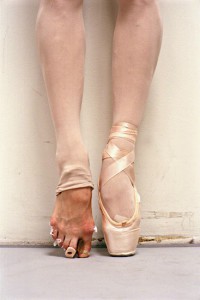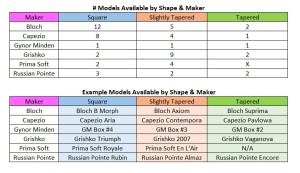Interested in reading my ballet fiction? To celebrate World Ballet Day 2023, enjoy A Dancer’s Guide to Africa for FREE by clicking HERE. Enjoy the first book of the Ballet Theatre Chronicles, Off Balance, for only 99 cents HERE. And check out your favorite ballet company’s YouTube channel to find archived live-streamed class, rehearsals and interviews from the big day!
Back in the late 18th century, the ballet world decided that female dancers should look ethereal, sylph-like, as if they could fly. A theater man named Charles Didelot came up with a flying mechanism, via harness and pulleys, that allowed dancers to rise to their toes before becoming wholly airborne, wafting across the stage like a spirit. Audiences at it up. Choreographers factored the philosophy of it into their work, even though no shoe existed to help the female rise to that tippy-top place.
Now, in 1823, you had the Italian dancer, Amalia Brugnoli, who managed to rise up to the tips of her toes by pure brute strength, in Armand Vestris’ La Fée et le Chevalier. In her stitched, square-toed satin slippers, it was her toes doing all the work, and probably looked as uncomfortable as it felt. But it gave Marie Taglioni ideas, and in 1832, she became the first to officially dance en pointe in her lead role in the ballet, La Sylphide. She’d fortified her satin slippers with leather soles, darning the sides and toes to create a bit of a box at the toe base, and stuffing the tips with a little cushion.
And so it began. Amalia Brugnoli, Marie Taglioni, Pierina Legnati, Anna Pavlova: these pointe shoe pioneers steered us in the direction of the shoe that ballet dancers wear to this day.
But you didn’t come here for a history lesson, did you? You want odd facts. So, here you go.
Ten Odd Facts About Pointe Shoes
1) They hurt the feet (in case the above graphic didn’t aptly drive that point in for you). You’re probably thinking, no, no, the professional dancers I’ve seen look so relaxed and smiling. The shoes probably feel as comfortable and relaxing as bunny slippers by the time a dancer turns professional. Um, not. (Check out my post, “10 reasons those pointe shoes hurt,” HERE)
2) They are handmade, and it’s very cool to watch one being made. The box of the shoe is composed of many layers of burlap, or buckram felt, all slathered with with a pasty glue. A picture here is worth a thousand words; check out the video below.
3) They are the prettiest thing in the world when you take them out of the box, but utterly unsafe and painful to dance on, in that condition.
4) They are expensive, averaging $80-$100 a pair. Professional ballet companies provide pointe shoes for their dancers (80 pairs a year on average, which depends wholly on the company’s financial status and budget for such a thing. Some companies can only offer 20 pairs per dancer, while others offer 120).
5) They are noisier than you can imagine until you break them in. Even then, they can sound like tap shoes on a stage. The dancer must spend years training, learning how to land in a way that softens the sound, using the toes first and rolling down through the full foot. Quiet landings are an art in and of themselves.
6) Dancers break their new pointe shoes down in a rather violent way, including hammering the boxes, slamming them against walls, stepping on them, shutting a door on them, breaking the shanks, slashing the soles, then, ironically, pouring in glue or floor wax to toughen them up. Understand, though, that they only apply glue/floor wax to the spot where toe meets the ground (the first spot that goes and HURTS when it’s soft).
Remember that video I promised? This is THE coolest video on pointe shoe making, and un-making, created and presented by the Dutch National Ballet. In the course of two minutes, you see both the maker crafting the shoe and the ballerina breaking the shoe in. Way cool.
7) Pointe shoes have a very short shelf life. One night of performing, or even half a night if your role is demanding. Sometimes professionals will sew themselves into their shoes (like, into the tights). Or sew stitches in the knot to tack the endings so they don’t come out mid-performance, little flapping inch-long bits of pink satin. Because, by night’s end, the shoes are dead.
8) There’s no left and right shoe. You get to pick (but not switch them around, thereafter). A neat trick, if, like me, one of your feet is slightly larger than the other: you can buy two pairs and divide them up to form two pairs with mismatched sizes that suits your foot.
9) They never have ribbons sewn on when you buy them. You do the work, which allows you to customize precisely where the ribbon will fall. Most dancers will incorporate some elastic into the equation, as well. The amount of time professional ballet dancers spend on sewing ribbons and elastic to pointe shoes is a lot.
10) There are twenty-one manufacturers producing pointe shoes these days, and within each manufacturer, there are varieties, usually having to do with the shape of the box. Which means there are over 100 choices to try in finding That Perfect Fit. Here’s a nifty chart to illustrate.
A bonus odd fact. The fascination, and the aspiring dancers’ obsession with pointe shoes will never, never end. No matter how much the shoes cost, or hurt, or the years of classes required to prep and strengthen the feet, they are the Holy Grail for many, many a dancer. Not just young dancers, either, now that I think of it. Adult dancers, regretful of passing up the opportunity during adolescence, when they’d dropped ballet in favor of middle school activities. Dozens of blogs exist, about pointe shoes, about the journey of dancing en pointe as an adult. One of my favorites is fellow dance blogger Johanna’s Pointe Til You Drop, where, among other interesting topics, she offers an elegant how-to on sewing ribbons onto new pointe shoes]. http://pointetilyoudrop.blogspot.com/p/pointe-shoes-how-to-sew.html. And check out the site Straight to the Pointe, hosted by a professional pointe shoe fitter, for more details and articles on all things pointe. http://straighttothepointe.net
PS: Want to take a pair of your own pointe shoes and make them more decorative? Check out The Shoe Buddy’s article, which offers 10 pointe shoe decorating ideas HERE.
PPS: Check out my sister article, “10 reasons those pointe shoes hurt” HERE
PPPS: HERE is another fantastic article I just discovered (in 2019) by the blog, Ballet Focus.
PPPPS: If you liked the video on how pointe shoes are made and you’d like to see a longer version, here’s a wonderful 26 minute video on the subject. Very educational and entertaining to watch.Click HERE.






Didn’t really help but nice facts
Well, I’m glad you liked the facts, at least. : )
This is the greatest collection of information thank you very much!
You’re most welcome, Jess! I get tons and tons of views to this page, which is great, but it’s always fun when someone takes the time to tell me they liked it. So, thank YOU! : )
I enjoyed this thankyou! But Im left wondering why no one has tried to make a ‘broken in’ shoe?
Hi Ruth, and thanks for your comment! I think the reason they stick with making shoes the way they do is so that each dancer can make adjustments that work for their feet. Someone with bunions is going to want a section of the box to be much softer than someone with bad corns on their pinky toes, who’d prefer it soft there, and hard against the big toe. Each person’s arch is different, as are the toe lengths (and, within the toes, some people have a second toe that’s possibly much shorter/longer, compared to someone whose toes are relatively even across). And even though a shoe will have its perfect “broken in” period, it doesn’t mean it’s unusable thereafter. Or before. If the shoe were pre-softened, its short life would be shortened even further. Too much $$ for too little time!
Gaynor Minden makes a pointe shoe that sort of addresses your question/issue. Here’s an interesting FAQ page – check it out! https://dancer.com/about-gaynor-minden/about-our-shoes/faq/
I am getting my point shoes soon and I am so happy to get them but also nervous for the pain at least there pretty!
Congratulations, Laila! Yes, they are both pretty and painful. They will become more comfortable as you learn how to break them in. Have fun!